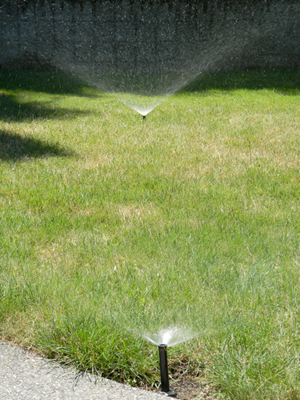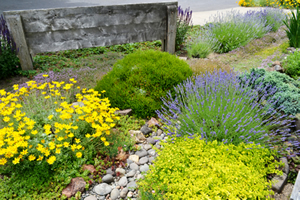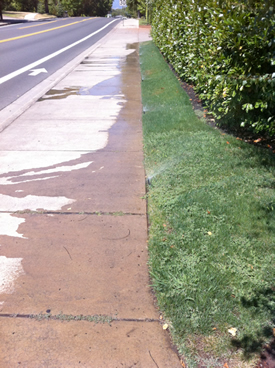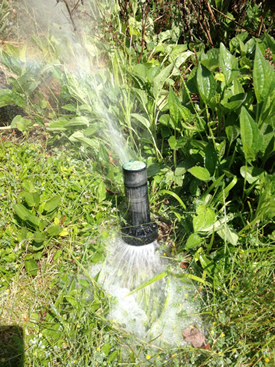- TABLE OF CONTENTS
- GETTING STARTED
- DESIGN
- Introduction to Design
- Questionnaire
- Principles of Design
- Creating the Design
- Drainage
- Plant Design
- Installing the Garden
- Working With Professionals
- IRRIGATION
- Introduction to Irrigation
- Plant Water Needs
- Before You Design
- Smart Controllers
- Types of Irrigation Systems
- Eliminating Run-off and Overspray
- MAINTENANCE
Water Saving Tips
Tip 1: Water between sunset and sunrise when temperatures and wind are the lowest.

Watering during the middle of the day can result in a 30% increase in required water due to evaporation and wind. Midday watering may even damage your plants. To decrease water loss from midday watering, LADWP’s water conservation ordinance requires residents to water before 9:00 am or after 4:00 pm. To further maximize watering efficiency, we recommend that residents water between sunset and sunrise to minimize evaporation and wind effects.
Tip 2: Group plants with similar watering needs in the same area.

Different areas of your landscape have various water requirements. The same sprinkling schedule usually won’t work for your entire landscape. Sunny areas need more water than areas in the shade, each plant has its own specific watering need and different sprinkler types apply water at varying rates.
- Shrubs and trees are much different from lawn and require a much different watering schedule. Shrubs tend to need 1/3 to 2/3 as much water as lawn and with more robust root systems, benefit from less frequent but deep sprinkling.
- Standard spray heads, rotating sprinklers and drip irrigation all apply water at different rates so should all run on separate zones and with separate watering schedules. To achieve a uniform water application, it is important that all sprinklers within a sprinkler zone apply water at similar rates.
Tip 3: Mulching and adding compost to soil can minimize evaporation and help soil absorb and store water.

Mulch is any material spread over the soil surface to retain soil moisture, moderate soil temperature, and/or suppress weed growth. Mulches can be either organic or inorganic.
- Organic mulches include things like compost, grass clippings, straw, aged animal manure, pine needles, leaves, bark, and wood chips. These materials can improve water absorption, add nutrients to the soil as they break down, insulate soil in winter, cool soil in summer, help prevent soil compaction, help prevent erosion, and suppress weed growth.
- Inorganic mulches include rocks, gravel, or sheeting. While these materials can suppress weeds and lessen erosion, inorganic mulches can also absorb and re-radiate the sun’s heat. This can actually increase the amount of water that surrounding plants need.
Soil improvement is very important for water efficient landscaping. Clay absorbs water so slowly that the water will run off if applied too quickly. Sandy soils absorb water quickly but do not have a good “holding capacity” (water available to plants). You should consider working generous amounts of organic soil amendments (such as compost) deeply into the soil before planting or lawn renovations.
Tip 4: Adjust sprinklers to avoid watering sidewalks and driveways.

A well-designed modern automatic sprinkler system can provide years of dependable service. However, they still contain many mechanical and electrical parts that can fail over time. Other components can be knocked out of alignment or even broken during routine landscape maintenance. To complicate matters, most irrigation system’s operation will occur during non-daylight hours. This makes it easy to miss sprinkler system problems. This is why it's a very good idea to occasionally observe your sprinkler system’s operation.
Tip 5: Be sure to fix all leaks promptly no matter how small they may seem.

Even a small leak can waste hundreds of gallons of water. Once a month run your system in manual mode to check for leaks or breaks. This helps protect against plant loss and offers a simple way to conserve water.
Also, look for broken or tilted sprinkler heads, rotors stuck in place, misting (indicates water pressure is too high), uneven water coverage due to head spacing (water sprayed from each sprinkler head should reach adjacent sprinkler heads), heads not at grade (too high or too low), mismatched sprinkler heads and nozzles ( prevents even precipitation rates) spray patterns blocked by plants, clogged nozzles or drip emitters, clogged filters, leaking or separated drip lines or missing emitters.